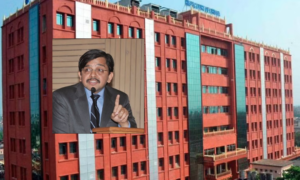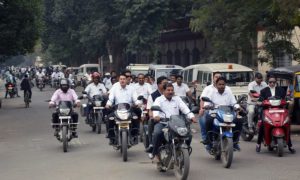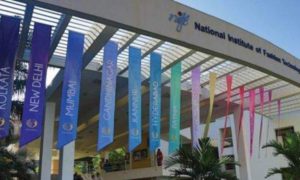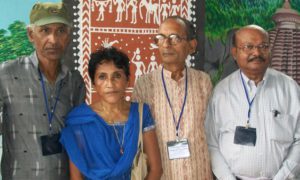 Ram Sarup nervously paced the corridor of Deep private hospital in Haryana’s Rewari district. A resident of Budhpur village, some 10 kilometers from Rewari, this was the first time 33-year-old Sarup had mustered up the courage to step into a private hospital. With a card clutched tightly in his hand, he tried to figure out the admission and payment process involved.
Ram Sarup nervously paced the corridor of Deep private hospital in Haryana’s Rewari district. A resident of Budhpur village, some 10 kilometers from Rewari, this was the first time 33-year-old Sarup had mustered up the courage to step into a private hospital. With a card clutched tightly in his hand, he tried to figure out the admission and payment process involved.
“It’s been almost a month that I have been feeling tired…. A couple of times, I have had a fever as well …. Executing a small task drains me completely. This card, I was told, entitles me to free treatment here. They will also pay me US$2 as transportation cost,” says Sarup, even as he seems to find it difficult to breathe.
Good health is all Sarup, a laborer, has to bank on for survival. A non-productive day for him means no wages and hence no food. And an illness often means getting caught in what American economist Jeffrey Sachs has described as a “health-based poverty trap.”
But thanks to the card in question — a Rashtriya Swasthya Bima Yojna (RSBY) smart card — chances are that Sarup may be saved from falling further into poverty due to illness or the costs of treating his condition. So might 28.6 million other RSBY card holders and their 115 million family members across India. The latest poverty estimates by the Planning Commission of India estimates that the country’s poor number about 360 million. Launched in April 2008 by the Union Ministry of Labor and Employment, the RSBY initiative provides health insurance coverage for Below Poverty Line (BPL) families. The idea is to provide protection to BPL households from financial liabilities arising out of health shocks that involve hospitalization.
Beneficiaries under RSBY are entitled to hospitalization coverage up to US$600 (at the exchange rate of Rs. 50 to a U.S. dollar) for most of the diseases that require it. The government has even fixed the package rates for the hospitals for a large number of interventions. What sets the program apart is the fact that it even covers pre-existing conditions and there is no age limit. The coverage extends to five members of the family, which includes the head of the household, the spouse and up to three dependents. The beneficiaries need to pay 60 U.S. cents as a registration fee and the central and state governments pay the premium to the insurer. The insurance company is selected by the state government on the basis of competitive bidding.
Presently, 13 insurance companies are implementing the program in partnership with RSBY. A total of 10,862 hospitals have been enrolled under RSBY — 7,576 private facilities and 3,286 that are government-owned. The central government finances up to 75% of the premium, while the respective state governments pay the remaining 25%. For the North-Eastern states and Jammu & Kashmir, the expenditure is shared in the ratio of 90:10.
Since the inception of the initiative four years ago, it has covered 400 districts in 24 states — recording over 3.4 million hospitalizations from BPL families. The program is even operational in Naxal-prone districts (such as Gajapati, Malkangiri, Rayagarh, Sambalpur and Deogarh), which have experienced much anti-government violence and kidnappings.
Anil Swarup, director general for labor welfare in the Union Ministry of Labor & Employment, has been at the helm of the program from day one. He looks at RSBY as a social sector scheme that is riding on a business model. It incentivizes performance of all the stakeholders involved: Insurance companies are attracted by the volumes the initiative creates. Private hospitals no longer look askance at poor patients because they carry a credit of US$600. Anecdotal evidence suggests that private hospitals have been upgrading their facilities in order to lure more poor patients. The program gives them a steady source of income. It also eases the pressure on already overburdened government hospitals. The central government allocation for the scheme has increased from US$50 million in 2008-2009 to US$313.7 million in 2012-2013.
“To begin with, our target was to enroll only BPL families — the scheme therefore had to be cashless,” Swarup says. “And given that the majority of these people are also illiterate, we had to develop a paperless scheme. It also had to provide interoperability to facilitate use by migrant labor. Our solution, thus, had to be valid across geographies.” The smart card emerged as the answer. “The RSBY card has financially empowered the BPL person in the real sense because he can now make a choice of delivery point,” Swarup adds. “Biometric verifications are done and cards are issued on-the-spot. Not a single card has fallen in the wrong hands.”
High Satisfaction Levels
This is possibly the reason why surveys conducted by the ministry so far have indicated a beneficiary satisfaction ratio ranging between 77% and 92%. Access to the hospitals for the poor has gone up from 1.7% to 2.7%, according to the National Sample Survey Organization. The International Labor Organization and the United Nations Development Program (UNDP) have selected RSBY as one of the 18 innovative case studies from around the world in the field of social protection.
However, the fundamental question is whether the US$600 insurance cover is really sufficient. “The US$600 cover is very good,” says D. Rajasekhar, professor at the Center for Decentralization & Development at the Institute for Social and Economic Change in Bangalore. “There are three types of health care: primary, secondary and tertiary. The primary health care [including immunizations and preventative care] is provided by the institutions at the village level, such as the Primary Health Centre. The tertiary care involves hospitalization or surgery for major ailments such as heart attack, cancer and renal disease. In general, the expenditure incurred for tertiary treatment ranges between US$3,000 and US$4,000. On the other hand, secondary care involves hospitalization for a few days or surgery of minor types. Our study showed that the average expenditure for this is low and can certainly be covered by the RSBY.”
D. Karthik, a professor at the Indian Institute of Management in Ahmedabad, is currently working on a paper on RSBY. He regards the scheme as an enabler that has transferred the task of providing last-mile connectivity to the private sector. “US$600 would not have been enough if the disease-wise cap on the hospitalization bill had not been provided,” he notes. “Moreover, this number is like the minimum being provided to start with. As the scheme matures, the amount is likely to be revised. The state governments are [also] free to offer top ups.”
State Schemes
The flexibility in the program design has led the state of Himachal Pradesh to extend the insurance cover to US$3,500 per annum. Kerala, on the other hand, had an additional one million poor families over and above the 1.18 million families classified as BPL by the Planning Commission. In a move to embrace them all, the state decided to fund the entire premium for the former group. “Kerala is one of the pioneer states for RSBY,” says Murali Rao, associate vice president for health care at the New Delhi–based research and consultancy firm Technopak Advisors. “It launched the Comprehensive Health Insurance Scheme (CHIS) for providing tertiary care to cardiology, oncology and nephrology patients up to US$1,400 over and above the RSBY coverage of US$600.” Other such initiatives are also being run by local state governments to help BPL patients in their health care needs, especially treatments like congenital heart diseases and cardiac surgeries, Rao adds.
Strong support from the states is undoubtedly a key to the success of RSBY, experts say. But the support has been mixed. Rajasthan had initially implemented the scheme but stopped after a year; the state government didn’t market it adequately. It has once again initiated the process. Tamil Nadu, too, participated in the scheme initially but discontinued. It launched its own initiative in 2009 called Kalaignar’s Insurance Scheme for Life Saving Treatments. Andhra Pradesh has not participated in the RSBY program as it has its own health insurance (the Rajiv Aarogyasri Health Insurance Scheme.) On the other hand, Karnataka, which has its own scheme (Yeshasvini Cooperative Farmers Health Care scheme), is actively implementing RSBY as well.
The Union Government has other schemes, too. While RSBY aims to cover all those registered below the poverty line, the Janashree Bima Yojana (JBY), implemented through the Life Insurance Corporation of India was launched in 2000 with the objective of providing life insurance protection to the rural and urban poor under various vocational groups. Aam Admi Bima Yojana (AABY), on the other hand, covers death and permanent disability for the benefit of rural landless households.
The Economic Survey 2011–2012, the flagship annual document of the Union Ministry of Finance, has highlighted the issue of convergence of programs. According to the survey, despite a lot of talk, nothing has been done. “For example, there are the AABY, JBY, and RSBY with significant overlap and catering to same or similar categories of the population.” But recently there have some developments in that area: The finance ministry will now use the RSBY delivery mechanism to provide life insurance cover to the poor under the JBY. “There is demand for space in the RSBY chip for housing other additional socio-economic and health-related data as well,” Swarup notes. “Other government schemes related to pensions, etc. may also ride on this card in the future. Soon the capacity of the card will be upgraded from 32 kilobytes to 64 kilobytes.”
Recently, other categories of people were also added to the scope of the RSBY. They include building and other construction workers, Mahatma Gandhi National Rural Employment Guarantee Act (MNREGA) beneficiaries, street vendors, beedi (an Indian cigarillo) workers and domestics. This expansion has created an added patient volume to be taken care of. Just one of these categories — street vendors — was recorded at 4.22 million in Census 2001.
An RSBY Out Patient Department (OPD) pilot is underway in two districts — Puri in Odisha (earlier Orissa) and Mehsana in Gujarat. The outcome of these two pilots will decide whether or not RSBY will roll out OPD services on a pan India basis. So far the average per head hospitalization expenses in the scheme is approximately US$100. Will an added OPD burden impact the sustainability of RSBY in any way? “We should be able to take care of both OP and IP (inpatient) within the US$600 ceiling,” notes Nishant Jain, an expert on social protection with German development cooperative GTZ, who is working closely with Swarup to implement RSBY. “Besides, once OP gets covered, IP expenditure will come down as any disease will then be tackled right at the outset. So the overall premium will then get reduced.”
Leadership at Apollo Munich Health Insurance, a partner of RSBY, is thinking on the same lines. “We are looking at ways to expand the coverage, perhaps to include OP,” says company CEO Antony Jacob. “We also have plans to extend the scope of the treatment beyond insurance and to include items such as mosquito nets in the scope of the coverage. The bulk of our focus is on the North-Eastern part of the country, which is known to be the poorest and most in need of health insurance coverage. We cover the entire states of Meghalaya and Nagaland and one district in Bihar, in addition to a small presence in Maharashtra.”
The success of RSBY will eventually depend on whether the business model is working, experts say. The average burnout ratio (the percentage of money spent by an insurance company on RSBY as a percentage of the premium it receives from the government) is 74.08%. “According to the data, insurance companies are not making a lot of profit in the scheme…. They have lost some money in the second year,” says GTZ’s Jain. But K. Gopinath, head of rural and cooperatives at insurance company Iffco Tokio is “confident of making it viable by the end of this year.” And for Apollo Munich’s Jacob “the venture has more or less been on a break-even basis.”














